↓ Download the Full Newsletter (PDF)
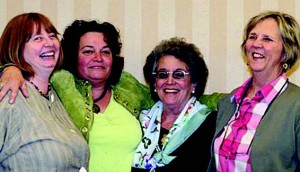
A Message from The Friends Of Hall’s Pond Co-Presidents
Ellen Forrester and
Betsy Shure Gross
On behalf of The Board of Directors of The Friends of Hall’s Pond, we want to welcome all who use Hall’s Pond Nature Sanctuary, to thank our wonderful very special Volunteers, and note our appreciation to the Brookline Conservation Commission Commissioners and to their staff, Tom Brady and Heather Charles for their untiring efforts on behalf of this unique Brookline resource. We are proud to be your partners in the protection and preservation of Hall’s Pond.
In the heart of Coolidge Corner, steps from the activity of a vibrant residential and commercial neighborhood, hides an urban treasure. As the Hall’s Pond Brochure advises users, Hall’s Pond contains a mix of landscaped and more natural elements. Due to its varied plant communities and the fact that it includes one of the few wooded ponds in our area, a surprisingly diverse population of plants and animals exist on this five acre conservation land. And, of course, this makes Hall’s Pond a four season “oasis in the city,” a place which hosts the Brookline GreenSpace Alliance Learning Project with Conservation Commissioner and well known naturalist Gail
Fenton; a destination for bird watchers; those seeking solitude for renewal and contemplation; using the accessible Wetland Bridge and Pond Overlook board walk; for photographing trees, native and wetland plants, the Formal Garden, wildlife, the Wooded Wetland, the Upland and Amory Woods with its gazebo and small woodland and spectacular Northern Red Oak tree.
The Friends of Hall’s Pond ask you to join us as we work in partnership with the Brookline Conservation Commission to plan for and protect this special urban nature sanctuary. We welcome you to our Community Work Days and to our educational and fund-raising initiatives. We encourage your participation in this public private partnership and hope that you will visit the sanctuary often and become interested in the role that you can play as a steward of this special site. We would welcome your gift of time and love to see your photographs of gentle activity at Hall’s Pond.
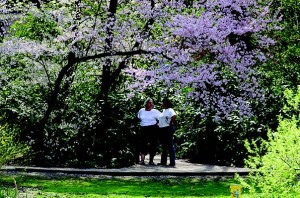
The Learning Project
By Arlene Mattison, President, BGSA
We spent 11/2 hours exploring, digging for insects, observing turtles, seeing a rare heron, climbing on logs, smelling wonderful smells, observing the snails on the reeds… I could go on and on. This service that you all provide makes it possible for all schools to have powerful nature experiences…
E-mail from Mary McConnell, Driscoll School in 2007
Brookline GreenSpace Alliance adopted the Hall’s Pond Learning Project in 2004 from The Friends of Hall’s Pond with the goals of maintaining the already high level of program quality established by the Friends and also of expanding the Learning Project to include the other two nature sanctuaries in Brookline. Since that transition, the Learning Project has grown into a multi-faceted program that continues the legacy of educational excellence established by the Friends.
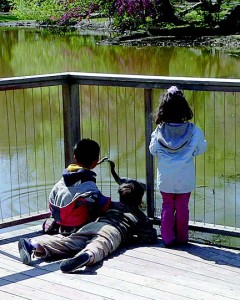
Photo Credit: Bruce Wolff
When BGSA adopted the Learning Project from The Friends of Hall’s Pond, it consisted primarily of field trips for public school students to the Hall’s Pond Sanctuary. Over the next five years, BGSA expanded that to include trips into D. Blakely Hoar Sanctuary and Lost Pond Sanctuary. In addition, BGSA decided to re-brand and refine its other additional educational programming and the Learning Project under the auspices of one program: the GreenSpace Environmental Learning Project.
Currently, the GreenSpace Environmental Learning Project consists of a public school portion and a general public portion. The general public portion features free monthly field trips into our various parks and open spaces. Trips include our Annual Watershed Walk, led by a hydrologist focusing on storm water drainage patterns and their importance to Brookline; our 10 Hills of Brookline Bike Tour; Winter Tree Identification Walks, led in the past by members of the Tree Planting Committee or by the Brookline Tree Warden; bus tours; bird walks and more. These trips give residents of all ages a chance to visit Brookline’s open spaces and to see them with environmentalists’ eyes.
The public school portion of the Learning Project continues to center on field trips led by a classroom teacher and our trained naturalist into one of our wetland sanctuaries. Our naturalist tailors these place-based educational outings directly into MCAS-framework lessons. This gives a unique chance to many urban students to see firsthand nature that they would not have a chance to see otherwise. This inperson experience, which has in the past included such enthralling events as watching a Black-crowned Night Heron dive for its lunch and looking at the eggs of an endangered Spotted Salamander, goes a lot farther to engender an environmental consciousness than reading about ecology in a book.
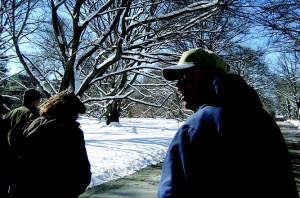
Photo Credit Hugh Mattison
As commented on by teachers like Mary McConnell, the Learning Project is an undeniably powerful tool to teach a future generation of advocates and responsible environmentalists. The Brookline Public Schools K-8 Science Curriculum Coordinator agrees with this and is herself an advocate of place-based education. It is difficult for the public schools to provide such programming. BGSA is the only organization offering such programming free in our community, so it is vital to continue, and if possible expand, the Learning Project.
Despite the current economic challenges, BGSA is still excited about and dedicated to the Learning Project. We continue to seek new grant makers and funders. And we continue to reach out to new partners in town such as the Science Curriculum Coordinator and the PTO’s in hopes of further improving the GreenSpace Environmental Learning Project.
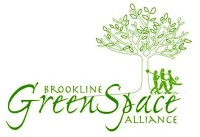 Brookline GreenSpace Alliance (BGSA) is a 501(c)3 organization formed in 1987 to preserve, protect and enhance the parks and open spaces in our community. Since then it has grown to a network of over 39 member organizations and approximately 1000 members who strive to protect and enhance green space resources throughout Brookline, a town of 57,000 enclosed on three sides by Boston. BGSA is the only organization of its type in town advocating and educating on behalf of local land conservation and enhancement. We pride ourselves in being THE grassroots support for our green community.
Brookline GreenSpace Alliance (BGSA) is a 501(c)3 organization formed in 1987 to preserve, protect and enhance the parks and open spaces in our community. Since then it has grown to a network of over 39 member organizations and approximately 1000 members who strive to protect and enhance green space resources throughout Brookline, a town of 57,000 enclosed on three sides by Boston. BGSA is the only organization of its type in town advocating and educating on behalf of local land conservation and enhancement. We pride ourselves in being THE grassroots support for our green community.
Marc and Jackie Fried
By Ferris Hall and Betsy Shure Gross
Early in the 1970’s when it appeared that Hall’s Pond might be lost to development, a small band of energetic conservationists and environmental leaders led by Jackie Zilbach Fried, who was on the Brookline Conservation Commission, a Town Meeting Member, as well as an abutter to Amory Park and the Pond, convinced the Town of Brookline to purchase the site. Through her work, and that of fellow Conservation Commission Members Lee Albright and later Betsy Shure Gross, and fellow Town Meeting member and abutter Ferris Hall, Hall’s Pond eventually became the Town’s first wild life sanctuary, and the adjacent parcel of land, Amory Woods, would be acquired a decade later.
Jackie made the protection and preservation of these sanctuaries one of the major causes of her active political and environmental life. She was a founding member and fervent supporter of The Friends of Hall’s Pond, helping to guide its partnership with the Brookline Conservation Commission. Meanwhile, Marc Fried established and nourished the Friends of Amory Woods. These two adjacent parcels were combined into the present Hall’s Pond Sanctuary in 2001.
On May 11, 2009, a beautiful Sugar Maple tree was planted on the Southwest entrance to the sanctuary (adjacent to the tennis courts) in honor and memory of Marc. The tree is a generous gift of the Fried children, Susana, Diana, Lise and Alan who, with their mother, Jackie, attended the dedication. Marc, a psychology professor at Boston College best known for his research into the adverse effects of urban renewal in Boston’s West End, and Jackie, a psychiatrist, lived at 36 Amory Street. There, for almost 50 years, they overlooked the grounds of the Sanctuary they helped to create.
Red-winged Blackbirds
By Edward Hsieh
A dozen years ago, Barbara Mackey, then president of The Friends of Hall’s pond and a driving force in the planned restorations, stood watching a Red-winged Blackbird at the pond. She said that Red-winged Blackbirds sometimes visited the pond, but never seemed to nest there. Wouldn’t it be great, she added, if they begin nesting here after the restoration? And once we get the Hall’s Pond Learning Program up and running, she added, we can bring school children to see them, right in our own backyard.
This spring, school groups watched in delight as the nesting Red-winged Blackbirds swooped at the great blue herons each time the much larger birds got too close to the blackbird’s nests. The children heard Baltimore Oriole chicks squawking for food from their nests and pointed out the three cormorants and two black-crowned night herons that often visited the pond.
Even school children get interested in the native plants, most of which were added as part of the restoration, that have developed into a functioning wildlife habitat. They learn about the native jewel weed, whose seed pods spring open at a touch to fling its seeds into the future, about the cattails, that look like corndogs at a carnival, and about the blue-flowered pickerel weed, where snails crawl in fascinating numbers.
Over the years, the Hall’s Pond Learning Project has been expanded as the Brookline Environmental Learning Project, under the management of the Brookline Greenspace Alliance. Each school year, local school groups arrange for naturalist-led educational programs at Hall’s Pond. The programs are free, and are designed to complement the teachers’ curriculum. Many classes are able to walk or take the trolley to this remarkable spot. Fall and winter programs can be reserved by contacting BGSA, at info@brooklinegreenspace.org.
In and Around the garden
By Ellen Forrester
Things are quieting down in the garden and sanctuary for the year. The bees are slow and the birds are heading south, but keep your eyes open during this migration season. The big planting at the spring work day was a huge success. It couldn’t have been done without your help.
We were able to put in: fifty 1-gallon Atlantic White Cedar Chamaecyparis thyoides, thirty two 4-inch seedling Atlantic White Cedar Chamaecyparis thyoides, thirty 1-gallon Highbush Blueberry Vaccinum corybosum, ten 1-gallon Inkberry Ilex glabra, ten 1-gallon Winterberry Ilex verticilatta and five 1-gallon Spicebush Lindera bezoin. On a recent look around we had quite a success rate for these plants over the summer. Over time all this work in replanting the cedar swamp will have many great benefits to our visitors and wildlife.
There were many extra work days in the formal garden over the summer. Thanks go to Bruce Wolff for organizing the times to do some invasive removal and general garden maintenance. We hope that next year we can focus more time in planting and maintaining the formal garden. We of course can always use your help. Watch the bulletin Board for information.
A big thank you and congratulations go to all our dedicated volunteers.
Parks, Plants and People
By Ellen Forrester
Parks, Plants and People: Beautifying the Urban Landscape is the title of the newly released book by Lynden Miller. The Friends of Hall’s Pond was a major sponsor for this presentation on October 7, 2009. A group from The Friends of Hall’s Pond joined The Community Outreach Group for Landscape Design (COGDesign.org) for an evening presentation by Lynden Miller discussing her work as a public garden designer. The evening brochure says it all in that Lynden Millers’ projects in New York City are urban oases with economic benefits and the power to transform the way people behave and feel about their city. She has always believed in the amazing power of greenspace as a way of improving city life. Transforming was a big word for the evening. Transforming urban spaces into sanctuaries, beautiful useful connections to nature, improves daily lives but also has economic benefits to a community. Improved public safety and increased real estate values matter to all of us. Lynden Miller truly believes that the people should be inspired to beautify their own cities. In these trying economic times, a connection to nature can be a powerful thing. Now more than ever this can only be accomplished by volunteers working in partnership with the government agencies responsible for capitol investment and ongoing maintenance. By caring for urban spaces, people notice. By taking part in the care of these public spaces it gives a sense of connection to a place and improves the quality of life where you live.
We are quite fortunate that The Hall’s Pond sanctuary has such a great group of volunteers and stewards and a good working relationship with the Town. This urban oasis depends on everyone for advocacy and continued care. Let’s keep up the good work.
Hall’s Pond Sanctuary Work Plan
By Randolph Meiklejohn
In fall 2009, members of The Friends of Hall’s Pond Board of Directors and of the Brookline Conservation Commission met to begin preparation of a planning document to guide seasonal and long-term maintenance and clean-up activities at the sanctuary. When completed, it will be the first joint publication of the Friends and the Commission since the 1996 “Plan for Hall’s Pond Sanctuary,” and will mark an important milestone in the maturation of the Friends as well as the sanctuary itself.
For the Friends, the value of the work plan is that it will provide practical guidance for community work days and for other Friends projects so that these activities support protection of wildlife habitat and of the investments made in the sanctuary’s restoration. The plan authors are endeavoring to make the document field-usable and easily understood by new visitors and volunteers, while also grounding its suggestions for practical tasks in a vision for the sanctuary’s future that incorporates the perspectives of the Friends, the Commission and of Town staff.
Collaborating on the work plan are Friends co-presidents Ellen Forrester and Betsy Shure Gross, Conservation Commissioners Gail Fenton and Randolph Meiklejohn (both also Friends board members), and Conservation Administrator Tom Brady. Tom has facilitated the group’s discussions and provided extensive information on the maintenance work performed by Town staff since the completion of the sanctuary restoration.
